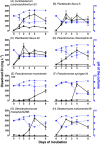Identification of Heterotrophic Zinc Mobilization Processes among Bacterial Strains Isolated from Wheat Rhizosphere (Triticum aestivum L.)
- PMID: 29079619
- PMCID: PMC5734027
- DOI: 10.1128/AEM.01715-17
Identification of Heterotrophic Zinc Mobilization Processes among Bacterial Strains Isolated from Wheat Rhizosphere (Triticum aestivum L.)
Abstract
Soil and plant inoculation with heterotrophic zinc-solubilizing bacteria (ZSB) is considered a promising approach for increasing zinc (Zn) phytoavailability and enhancing crop growth and nutritional quality. Nevertheless, it is necessary to understand the underlying bacterial solubilization processes to predict their repeatability in inoculation strategies. Acidification via gluconic acid production remains the most reported process. In this study, wheat rhizosphere soil serial dilutions were plated on several solid microbiological media supplemented with scarcely soluble Zn oxide (ZnO), and 115 putative Zn-solubilizing isolates were directly detected based on the formation of solubilization halos around the colonies. Eight strains were selected based on their Zn solubilization efficiency and siderophore production capacity. These included one strain of Curtobacterium, two of Plantibacter, three strains of Pseudomonas, one of Stenotrophomonas, and one strain of Streptomyces In ZnO liquid solubilization assays, the presence of glucose clearly stimulated organic acid production, leading to medium acidification and ZnO solubilization. While solubilization by Streptomyces and Curtobacterium was attributed to the accumulated production of six and seven different organic acids, respectively, the other strains solubilized Zn via gluconic, malonic, and oxalic acids exclusively. In contrast, in the absence of glucose, ZnO dissolution resulted from proton extrusion (e.g., via ammonia consumption by Plantibacter strains) and complexation processes (i.e., complexation with glutamic acid in cultures of Curtobacterium). Therefore, while gluconic acid production was described as a major Zn solubilization mechanism in the literature, this study goes beyond and shows that solubilization mechanisms vary among ZSB and are strongly affected by growth conditions.IMPORTANCE Barriers toward a better understanding of the mechanisms underlying zinc (Zn) solubilization by bacteria include the lack of methodological tools for isolation, discrimination, and identification of such organisms. Our study proposes a direct bacterial isolation procedure, which prevents the need to screen numerous bacterial candidates (for which the ability to solubilize Zn is unknown) for recovering Zn-solubilizing bacteria (ZSB). Moreover, we confirm the potential of matrix-assisted laser desorption ionization-time of flight mass spectrometry (MALDI-TOF MS) as a quick and accurate tool for the identification and discrimination of environmental bacterial isolates. This work also describes various Zn solubilization processes used by wheat rhizosphere bacteria, including proton extrusion and the production of different organic acids among bacterial strains. These processes were also clearly affected by growth conditions (i.e., solid versus liquid cultures and the presence and absence of glucose). Although highlighted mechanisms may have significant effects at the soil-plant interface, these should only be transposed cautiously to real ecological situations.
Keywords: MALDI-TOF MS; biofortification; bioremediation; metal solubilization; organic acids; proton extrusion; siderophores; wheat; zinc-solubilizing bacteria.
Copyright © 2017 American Society for Microbiology.
Figures

Similar articles
-
Characterization of zinc solubilization potential of arsenic tolerant Burkholderia spp. isolated from rice rhizospheric soil.World J Microbiol Biotechnol. 2021 Feb 5;37(3):39. doi: 10.1007/s11274-021-03003-8. World J Microbiol Biotechnol. 2021. PMID: 33544268
-
Growth improvement of wheat (Triticum aestivum) and zinc biofortification using potent zinc-solubilizing bacteria.Front Plant Sci. 2023 May 12;14:1140454. doi: 10.3389/fpls.2023.1140454. eCollection 2023. Front Plant Sci. 2023. PMID: 37251763 Free PMC article.
-
Solubilization of insoluble zinc compounds by zinc solubilizing bacteria (ZSB) and optimization of their growth conditions.Environ Sci Pollut Res Int. 2018 Sep;25(26):25862-25868. doi: 10.1007/s11356-018-2638-2. Epub 2018 Jun 29. Environ Sci Pollut Res Int. 2018. PMID: 29959742
-
Zinc-solubilizing bacterial consortia: a promising approach for zinc biofortification of crops.Front Microbiol. 2025 Jun 25;16:1575514. doi: 10.3389/fmicb.2025.1575514. eCollection 2025. Front Microbiol. 2025. PMID: 40636493 Free PMC article. Review.
-
Plant Growth-Promoting Soil Bacteria: Nitrogen Fixation, Phosphate Solubilization, Siderophore Production, and Other Biological Activities.Plants (Basel). 2023 Dec 5;12(24):4074. doi: 10.3390/plants12244074. Plants (Basel). 2023. PMID: 38140401 Free PMC article. Review.
Cited by
-
Curtobacterium oceanosedimentum-derived biosurfactants as eco-friendly biocontrol agent with broad-spectrum antibacterial and antifungal properties for sustainable applications.World J Microbiol Biotechnol. 2025 May 7;41(5):168. doi: 10.1007/s11274-025-04382-y. World J Microbiol Biotechnol. 2025. PMID: 40328999
-
Zinc-Solubilizing Streptomyces spp. as Bioinoculants for Promoting the Growth of Soybean (Glycine max (L.) Merrill).J Microbiol Biotechnol. 2022 Nov 28;32(11):1435-1446. doi: 10.4014/jmb.2206.06058. Epub 2022 Oct 17. J Microbiol Biotechnol. 2022. PMID: 36330749 Free PMC article.
-
Co-existence of Leclercia adecarboxylata (LSE-1) and Bradyrhizobium sp. (LSBR-3) in nodule niche for multifaceted effects and profitability in soybean production.World J Microbiol Biotechnol. 2019 Oct 31;35(11):172. doi: 10.1007/s11274-019-2752-4. World J Microbiol Biotechnol. 2019. PMID: 31673798
-
Core and Differentially Abundant Bacterial Taxa in the Rhizosphere of Field Grown Brassica napus Genotypes: Implications for Canola Breeding.Front Microbiol. 2020 Jan 15;10:3007. doi: 10.3389/fmicb.2019.03007. eCollection 2019. Front Microbiol. 2020. PMID: 32010086 Free PMC article.
-
Enhancing zinc levels in Solanum lycopersicum L. through biofortification with plant growth-promoting Pseudomonas spp. isolated from cow dung.BioTechnologia (Pozn). 2023 Jun 26;104(2):157-169. doi: 10.5114/bta.2023.127205. eCollection 2023. BioTechnologia (Pozn). 2023. PMID: 37427026 Free PMC article.
References
-
- Cakmak I, Yilmaz A, Kalayci M, Ekiz H, Torun B, Erenoglu B, Braun HJ. 1996. Zinc deficiency as a critical problem in wheat production in Central Anatolia. Plant Soil 180:165–172. doi:10.1007/BF00015299. - DOI
MeSH terms
Substances
LinkOut - more resources
Full Text Sources
Other Literature Sources
Molecular Biology Databases

